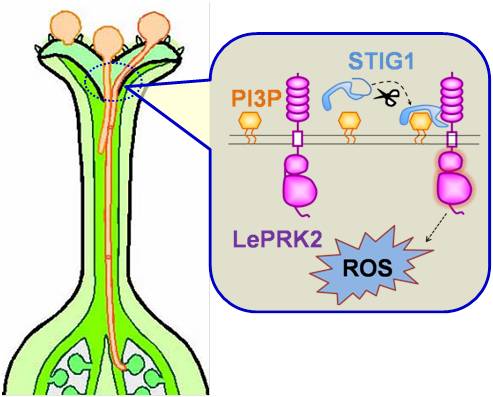Studies on STIG1-LePRK2 Signaling Reveals a Role for PI(3)P in Mediating Pollen-Pistil Interaction
The speed of pollen tube growth is a major determinant of reproductive success in flowering plants. Recently, a group led by Dr. TANG Weihua, from Shanghai Institute of Plant Physiology and Ecology (SIPPE), Shanghai Institutes for Biological Sciences (SIBS), CAS, presents in vivo evidence that a cysteine-rich peptide from stigma, STIG1, functions as a signaling molecule for the pollen receptor kinase LePRK2 and contributes to the rapid pollen tube growth in the pistil.
Although mature pollen from many species can germinate and grow rapidly in a simple medium supplemented with Suc, boric acid, and calcium, the elongation rate in vitro falls far short of that in the pistil. Pollen-specific receptor kinases (PRKs) have been implicated as candidate regulators for perceiving growth-promoting factors. Tomato STIG1, a small Cys-rich protein from the pistil, was previously identified as a binding partner of the pollen receptor kinase LePRK2 and shown to promote pollen tube growth in vitro. However, the in vivo function of STIG1 and the underlying mechanism of its promotive effect were unknown.
The researchers show that STIG1 is secreted and processed into an ~7-kD peptide in the stigmatic exudate. This processed peptide contains a LePRK2 binding site and a newly identified phosphatidylinositol 3-phosphate [PI(3)P] binding motif; both are required for its growth-promoting activity. Interestingly, STIG1 co-localizes with PI(3)P on the pollen tube surface. Using a redox-sensitive green fluorescent protein (roGFP), it was also found that STIG1 elevated the overall redox potential of pollen tubes in a PI(3)P-dependent and LePRK2-dependent manner. The finding that STIG1 binds to external PI(3)P on pollen tubes points to a novel role for PI(3)P in regulating polar cell growth and mediating cell-cell interaction.
This work entitled “Tomato Pistil Factor STIG1 Promotes in Vivo Pollen Tube Growth by Binding to Phosphatidylinositol 3-Phosphate and the Extracellular Domain of the Pollen Receptor Kinase LePRK2” has been published online in the Plant Cell on June 17, 2014.
The research was supported by the Natural Science Foundation of China (Grant 30970266 to and Grant 31170291) and the Ministry of Science and Technology of China (Grant 2012AA10A302).

Schematic model of STIG1-LePRK2 signaling in promoting pollen tube growth (Imaged by Dr. TANG Weihua’s group )
